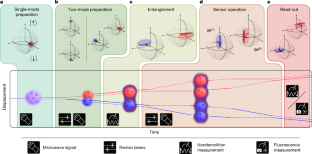原子レベルの精度で、電子を全く新しい方法で操作するテストベッドを構築し、量子コンピューティングへの応用を実現したのです。 With atomic precision, scientists built a testbed to manipulate electrons in entirely new ways with potential applications in quantum computing.
2022-11-28 アルゴンヌ国立研究所(ANL)
トポロジー(形の性質に関する数学の一分野)は、物質の物理学にユニークな知見を与えてくれる。トポロジカル絶縁体の表面に存在する電子は、ほとんど抵抗なく流れることができる状態にある。この状態は、量子情報技術における主要な課題である外部からのノイズや影響からシステムを保護することができる。
科学者たちは、このトポロジカル状態のような量子力学的現象が、より高速で安全かつエネルギー効率の高い情報の保存や通信にどのような力を発揮するかを探っている。
超高強度で電子伝導性に優れたグラフェンは、炭素原子からなる厚さ1Åのシートであり、さまざまな応用が期待されている。これまでの研究で、グラフェン・ナノリボン(グラフェンの小片)は、有望なトポロジー状態を示すことが示されている。研究チームは、このトポロジー効果のさらなる解明を目指し、人工グラフェンのテストベッドを原子レベルの精度で構築することに成功した。
人工グラフェンナノリボンを作ることで、厄介な実際のナノリボンを合成するのに比べて、システムをより正確に制御することができた。
研究者らは、顕微鏡の原始的な先端を利用して、CO分子を1つずつ銅の表面に置き、電子を閉じ込めて、本物のグラフェンナノリボンの炭素原子だけが示すハニカム構造を模倣することに成功したのだ。
その結果、人工ナノリボンは、研究者たちが本物に現れると予測したのと同じ電子的・トポロジカルな特性を示すようになった。
<関連情報>
- https://www.anl.gov/article/scientists-construct-novel-quantum-testbed-one-atom-at-a-time
- https://pubs.acs.org/doi/full/10.1021/acsnano.2c04361
人工グラフェンナノリボン。トポロジーと低次元ディラック物理のテストベッド Artificial Graphene Nanoribbons: A Test Bed for Topology and Low-Dimensional Dirac Physics
Daniel J. Trainer, Srilok Srinivasan, Brandon L. Fisher, Yuan Zhang, Constance R. Pfeiffer, Saw-Wai Hla, Pierre Darancet, and Nathan P. Guisinger
ACS Nano Published:August 15, 2022
DOI:https://doi.org/10.1021/acsnano.2c04361

Abstract
We synthesize artificial graphene nanoribbons by positioning carbon monoxide molecules on a copper surface to confine its surface state electrons into artificial atoms positioned to emulate the low-energy electronic structure of graphene derivatives. We demonstrate that the dimensionality of artificial graphene can be reduced to one dimension with proper “edge” passivation, with the emergence of an effectively gapped one-dimensional nanoribbon structure. These one-dimensional structures show evidence of topological effects analogous to graphene nanoribbons. Guided by first-principles calculations, we spatially explore robust, zero-dimensional topological states by altering the topological invariants of quasi-one-dimensional artificial graphene nanostructures. The robustness and flexibility of our platform allow us to toggle the topological invariants between trivial and nontrivial on the same nanostructure. Ultimately, we spatially manipulate the states to understand fundamental coupling between adjacent topological states that are finely engineered and simulate complex Hamiltonians.



